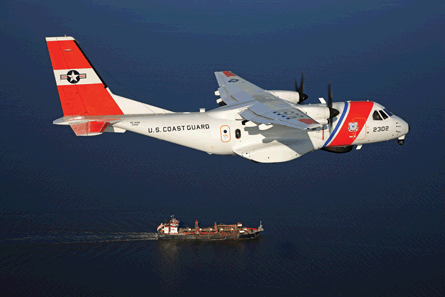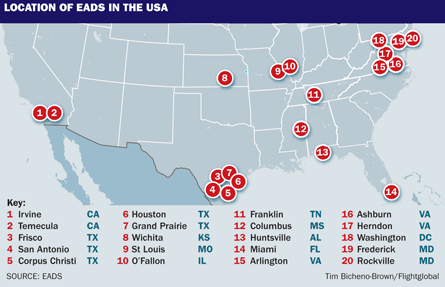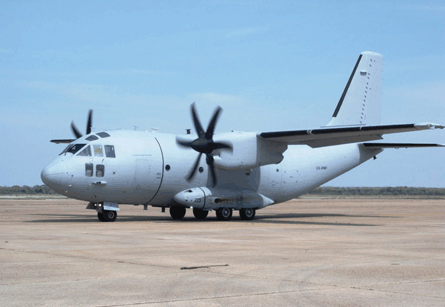Ever since the Beatles managed it, "cracking the USA" has been an obsession for European musicians. However, it appears that imperative also weighs equally heavily on the European aerospace industry.
Although the sector has some small footholds on the other side of the Atlantic, via the likes of BAE Systems and Finmeccanica, no one company has yet surfaced to challenge any of the US aerospace giants on their own turf.
EADS has perhaps come the closest. Until 24 February, when the US Air Force awarded the KC-X contest to Boeing, EADS appeared to have a strong chance of parking its tanker on Boeing's lawn. As well as the 179 aircraft up for grabs in the contest, EADS had promised, should it win, to move final assembly of its Airbus A330 Freighter to Mobile, Alabama.
 |
|---|
© US Caost GuardEADS North America has had some success in low-profile contests, selling its CN-235 to the US Coast Guard |
There is no doubt this would have given the company a significant foothold in the USA and was probably part of the reason that Boeing underbid EADS on the KC-X contract. After all, who wants your biggest rival pitching up on your doorstep?
Unfortunately for EADS, that is not how it played out, and it is a relatively minor player in terms of its US footprint, with its only significant aircraft manufacturing operations at American Eurocopter sites in Grand Prairie, Texas and Columbus, Mississippi.
That it remains a key concern is beyond doubt: unveiling its 2010 accounts on 9 March, chief executive Louis Gallois insisted that the USA was still one of "three pillars" on which he seeks to build the company (the other two are Europe and emerging economies).
EADS considers the USA as important for two key strategic reasons. Firstly, EADS has said that as part of its Vision 2020 plan it will balance the revenues generated by Airbus and its other divisions. Second, the company needs to reduce its exposure to fluctuating euro-dollar exchange rates.
On the first point, the scale of the challenge is clear from EADS's latest accounts: of the €45.8 billion ($64 billion) it generated in 2010, €29.9 billion came from Airbus. So, if that balancing act is to be achieved, sales in the USA are vital. As Guy Hicks, EADS North America vice-president corporate communications and public relations, points out, it is the largest defence market in the world, representing just under half of all defence spending.
"Even though the defence budget is going to normalise down it will still be significantly larger than anyone else," he adds. "It is difficult to [balance the defence and civil revenues] in the long term in a sustainable way without a solid base in the US. You are giving up half the world's market without even getting started."
That message is repeated by an analyst who asked not to be identified. He says although the Vision 2020 target "doesn't imply that you have to get that level of [non-Airbus] revenue in the US... it's very difficult to get it organically or from the rest of the world".
KC-X PAUSE
Although the loss of the KC-X contest was a disappointment, he notes, it is not a full stop for the company's stateside ambitions. "Does this mean the death of EADS's aspirations in the USA? Absolutely not. It is determined to continue to compete and win in other contests where it has relevant product. I also think it would be foolish to assume that it will not acquire any more companies in the US."
Although EADS North America has had some success in less high-profile contests - for instance developing the US Army's Light Utility Helicopter the UH-72A Lakota and selling its CN-235 aircraft, redesignated as the HC-144A Ocean Sentry, to the US Coast Guard - it has yet to win a larger deal.
EADS maintains it is happy with its US direction. Hicks says that in the eight years that the North American headquarters business has been active, it has gone from a company employing 20 people to 290.
 |
|---|
"Back then who would have thought that we would be able to compete against Boeing for the US's largest-ever programme [the KC-X] as prime contractor?" he asks.
He sees potential for EADS, via American Eurocopter, in two future helicopter contests: the army's Armed Aerial Scout, the replacement for the Bell OH-58 Kiowa Warrior, and the USAF's requirement for the Common Vertical Lift Support Platform, for which it could offer the Eurocopter EC175 or NH-90 (notwithstanding the USAF's position that it would rather no contest took place).
Beyond that, he believes the Airbus Military A400M could compete for any future airlifter requirement as the USA looks to replace its Lockheed Martin C-130 fleet.
With EADS sitting on a cash reserve of €12 billion, it is not beyond the realms of possibility that it would look to acquire a bigger footprint in the USA. However, here the company is at risk of running into a catch-22 situation, as Nick Cunningham, aerospace analyst at London firm Agency Partners, points out: the chances of winning a US contract without acquisition are low, but the chances of being allowed to make a large, strategic acquisition in the defence arena are lower still.
He adds: "Anything high profile is going to stay at home. Only by buying a US player will you win business there."
Other European aerospace players have also suffered from "dysfunctional US procurement", Cunningham notes. In his view, one of the most important aspects of the KC-X contest was EADS's plans to move assembly of the A330F across the Atlantic, taking work from Germany and France "without significant union opposition", thus reducing its exposure to exchange rate fluctuations. "That opportunity is now essentially lost," he adds.
Cunningham suggests an alternative way of achieving a similar outcome, given the right set of circumstances - booming A350 and A380 volumes and a robust backlog for the A330 - is to move the entire A330 final assembly line to the USA. But, if expansion into the USA has thus far been driven by the presumed need to balance the defence and civil markets, is this so vital to the business?
Not everyone agrees that there is a need to achieve this balance. "Clearly the core business is, and, for the foreseeable future, will be, Airbus. [Programme] execution, volume and pricing at Airbus will be of the utmost importance, together with the R&D spend and the level of the dollar," notes one analyst. "EADS has to get that core business right. Getting that additional revenue from defence is something that's good to have, but there's nothing as important as making sure the core business is performing."
This opinion is echoed by Sandy Morris, aerospace and defence analyst at RBS in London. In his view, the key to EADS's future rests less on achieving the objectives set out in Vision 2020 and more on ensuring the big civil programmes, particularly the A350, are delivered on time. "The A350 coming along more or less to deadline is absolutely fundamental. Screw it up and EADS could find itself stuck in the mire, get it right and it can move a long way."
REVENUE BALANCE
Conversely, if Airbus is successful with its A350 and A380 programmes, that makes achieving the balance of revenues under Vision 2020 even more difficult. "Unless Airbus turns out to be a commercial disappointment then it's virtually impossible," notes Morris.
Perhaps a more significant target for EADS is to be found in its Vision 2020 strategy. It reads: "Achieve best-in-class operational and financial efficiency to reach 10% EBIT in the first half of the decade 2010-2020." With EBIT at €1.3 billion, or 2.8% of revenue, it has some way to go to achieve this, so balancing the revenue streams seems less significant a problem and winning high-margin business becomes more vital, be that civil or defence work, and no matter its origin.
And could this be achieved by another route, with a much more Franco-centric focus? Imagine the potential profitability of a true French aerospace champion created by a merger of EADS, Thales and Dassault...
A RECENT HISTORY OF TRANSATLANTIC DEFENCE CO-OPERATION
The hsitory of transatlantic defence co-operation is fairly short. Traditionally, it was rare for British or European technology to wash on to US shores. The US Marine Corps' decision in the late 1960s to buy the British Aerospace Harrier was a significant departure from the norm, which usually involved trade going in the opposite direction.
But a key event in 1993 changed the almost exclusively one-way flow of trade in military aircraft and equipment. That was the Department of Defense-driven consolidation of the US defence aerospace sector in the early 1990s, referred to as the Last Supper, which created Lockheed Martin (from Lockheed and Martin Marietta), Northrop Grumman, Raytheon (from Raytheon and Hughes) and Boeing, which absorbed McDonnell Douglas.
While cataclysmic for the domestic industry, the Last Supper also had a substantial effect on transatlantic trade. The massive restructuring of the US defence industrial base meant that the Pentagon did not have so many mouths to feed. But the DoD lost access to competitive bidders in certain domestic markets, such as large commercial aircraft, and other niches, such as light transports and light utility helicopters, had no domestic market.
 |
|---|
© US ArmyFinmeccanica won Alenia C-27J business in the USA |
European contractors also consolidated during this time into big conglomerates, such as BAE Systems, EADS and Finmeccanica. To sustain growth, the larger firms needed to grow outside the limited European market for sophisticated weapon systems, and tap into the world's largest market - the USA.
European firms have pursued different routes. BAE's unique status as a benefactor of the "special relationship" between the USA and UK meant it could grow through acquisition. So the company bought US electronic warfare systems specialist Sanders in 1998.
With Italy enjoying slightly less privileged status, Finmeccanica has pursued a mixed strategy for US growth. Acquisition has seen it absorb DRS Technologies, it has moved production of some AgustaWestland helicopters to Philadelphia, while bidding with a US prime contractor, L-3 Communications, brought its Alenia C-27J success in the Joint Cargo Aircraft programme. EADS has made only minor acquisitions; instead, it focused on winning major contracts.
The response to these in-roads by European competitors has been predictable. The Pentagon has welcomed a new source of competitive sourcing with open arms, but the US defence industry has had more of a love-hate reaction. AgustaWestland has previously been described as a "socialist company from a socialist country" by one Sikorsky executive. Congress has been even more divided. Duncan Hunter, who was chairman of the House armed services committee between 2002 and 2008, attempted to legislatively eradicate foreign companies from all defence contracts, which would have wrecked several major programmes, including the Lockheed Martin F-35. Hunter was not successful, but the idea could always return.
It will not be any easier for European competitors. US defence spending is levelling off and appears to be on the brink of a potentially significant downturn. It will not be possible to grow by joining a rising tide. Any dollar earned by a foreign competitor will be necessarily taken from a domestic contractor, inflaming an already tense situation.
Perhaps more significantly, the Pentagon has changed its stance on lead systems integrators. No longer is the Pentagon willing to pay extra for an "integrator" to manage a massive, complex programme, such as the now-cancelled Future Combat Systems.
The lead systems integrators had proved useful to European competitors. To win the Joint Cargo Aircraft contract, Alenia believed it was necessary to team with L-3 Communications. This seemed essential, even though the only feasible competitor - the Airbus Military C-295 - was of Spanish origin.
Major near-term opportunities for European contractors in the USA include the T-X trainer contract and the air force's common vertical lift support programme.
It appears, however, that the air force wants to sole-source that to Sikorsky, rather than risk a potentially messy competitive acquisition.
Source: Flight International
















